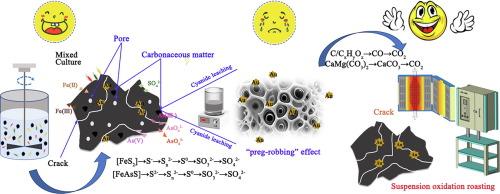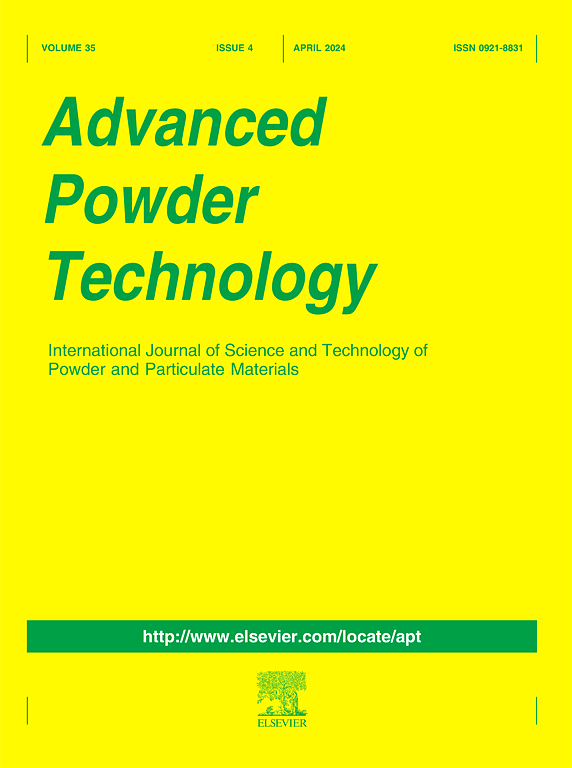Accelerating the decarbonization of bio–oxidation residues from carboniferous high arsenic sulfide refractory gold ores via suspension oxidation roasting for exceptional gold leaching efficiency
IF 4.2
2区 工程技术
Q2 ENGINEERING, CHEMICAL
引用次数: 0
Abstract
To address the low gold recovery following bio–oxidation of carboniferous high–arsenic sulfide refractory gold ores, this study proposes the application of suspension oxidation roasting as a secondary treatment strategy aimed at disrupting carbonaceous encapsulation and structural constraints, thus facilitating gold exposure and improving leaching efficiency. Thermal analysis employing TG–FTIR–GC–MS indicated that efficient decarbonization predominantly occurs within the temperature range of 550 °C to 650 °C, while arsenic volatilization remains negligible. XRD analysis further verified that pyrite and jarosite undergo thermal decomposition within this range, leading to the formation of stable iron oxides capable of immobilizing sulfur and arsenic. SEM–EDS and BET analyses demonstrated that the roasted residues exhibit a honeycomb–like porous morphology, which markedly increases surface reactivity and facilitates leachant infiltration. Under the optimized condition of 550 °C for 45 min, the carbonaceous removal efficiency reached 99.5 %, arsenic fixation exceeded 95.0 % and the gold leaching rate was significantly enhanced from 15.4 % to 80.2 %. These findings confirm the effectiveness of suspension oxidation roasting in enhancing gold recovery from bio–oxidation residues and provide both theoretical insight and technical support for the efficient treatment of carbonaceous high–arsenic sulfide refractory gold ores.

悬浮氧化焙烧加速石炭系高砷硫化难浸金矿生物氧化渣脱碳,提高浸金效率
针对石炭系高砷硫化物难浸金矿生物氧化后金回收率低的问题,本研究提出采用悬浮氧化焙烧作为二级处理策略,旨在打破碳质包封和结构约束,从而促进金的暴露,提高浸出效率。采用TG-FTIR-GC-MS进行的热分析表明,高效脱碳主要发生在550 ~ 650℃的温度范围内,而砷的挥发几乎可以忽略不计。XRD分析进一步证实,黄铁矿和黄钾铁矾在此范围内发生热分解,形成稳定的氧化铁,能够固定硫和砷。SEM-EDS和BET分析表明,焙烧残渣呈蜂窝状多孔形态,显著提高了表面反应活性,有利于渗滤液的渗透。在550℃、45 min的优化条件下,碳质去除率达到99.5%,砷固定率超过95.0%,金浸出率由15.4%显著提高到80.2%。研究结果证实了悬浮氧化焙烧提高生物氧化渣金回收率的有效性,为高效处理碳质高砷硫化物难处理金矿提供了理论见解和技术支持。
本文章由计算机程序翻译,如有差异,请以英文原文为准。
求助全文
约1分钟内获得全文
求助全文
来源期刊

Advanced Powder Technology
工程技术-工程:化工
CiteScore
9.50
自引率
7.70%
发文量
424
审稿时长
55 days
期刊介绍:
The aim of Advanced Powder Technology is to meet the demand for an international journal that integrates all aspects of science and technology research on powder and particulate materials. The journal fulfills this purpose by publishing original research papers, rapid communications, reviews, and translated articles by prominent researchers worldwide.
The editorial work of Advanced Powder Technology, which was founded as the International Journal of the Society of Powder Technology, Japan, is now shared by distinguished board members, who operate in a unique framework designed to respond to the increasing global demand for articles on not only powder and particles, but also on various materials produced from them.
Advanced Powder Technology covers various areas, but a discussion of powder and particles is required in articles. Topics include: Production of powder and particulate materials in gases and liquids(nanoparticles, fine ceramics, pharmaceuticals, novel functional materials, etc.); Aerosol and colloidal processing; Powder and particle characterization; Dynamics and phenomena; Calculation and simulation (CFD, DEM, Monte Carlo method, population balance, etc.); Measurement and control of powder processes; Particle modification; Comminution; Powder handling and operations (storage, transport, granulation, separation, fluidization, etc.)
 求助内容:
求助内容: 应助结果提醒方式:
应助结果提醒方式:


